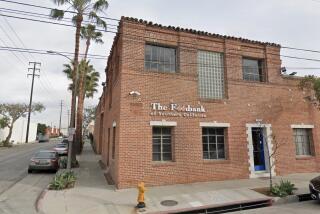Food pantries are seeing a new clientele
STOCKTON -- — Jackie Hoffman sifted through a laundry bin filled with aging bread, choosing a loaf of white.
Like nearly a third of the first 50 customers to arrive at the Emergency Food Bank of Stockton that morning, Hoffman was new to the pantry. But since she lost her sales job at a local newspaper in December, she has not found work in Stockton, which has the highest foreclosure rate in the country and a depressed job market.
“I’m down on my luck,” Hoffman said, squeezing and sniffing the bread. “And food is going through the roof. I need help.”
Hoffman, 55, is one of the growing number of “nontraditional” food pantry clients across the country. They include more formerly independent senior citizens, more people who own houses and more people who used to call themselves “middle class” -- those who are not used to fretting about the price of milk.
“We’re getting calls all the time from people who want to know how to get here,” said Kristine Gibson, community outreach manager at the Stockton food pantry. “And when I ask where they live, they give an address of a nice neighborhood, one where you or I would want to live.”
April saw the biggest jump in food prices in 18 years, according to the Labor Department. At the same time, workers’ average weekly earnings, adjusted for inflation, dropped for the seventh straight month.
To meet growing demand, America’s Second Harvest -- The Nation’s Food Bank Network has pressed lawmakers to increase the annual funding for The Emergency Food Assistance Program, commonly know as TEFAP, from $140 million to $250 million.
A survey it conducted of 180 food banks in late April and early May found that 99% have seen an increase in the number of clients served within the last year. The increase is estimated at 15% to 20%, though many banks reported increases as high as 40%.
The money was included in the Farm Bill recently approved by Congress, but won’t be available until the next fiscal year, which starts in October.
“The way it’s going, we’re going to have a food disaster pretty soon,” said Phyllis Legg, interim executive director of the Merced Food Bank, which serves 43 food pantries throughout foreclosure-ravaged Merced County.
Food banks across the country are in similar straits: While demand is up, supplies and donations are down. The banks, like their customers, also are suffering from high gas prices and struggling with the effect of rising food prices on their operations. Some have had to cut back on how much food they give, or how often.
“If gas keeps going up, it’s going to be catastrophic in every possible way,” said Ross Fraser, a spokesman for America’s Second Harvest.
Food banks sometimes have to move food 150 miles to a pantry, he said.
“You’re going to get to the point where they are going to have to decide whether it’s cheaper to just give a food pantry a check,” he said. “The price of gasoline is going to drive the price of everything else.”
Prices at the pump are at record highs, averaging just below $4 a gallon, and are expected to keep climbing.
Stories of want and need are mounting. In informal surveys, America’s Second Harvest has found a growing number of food banks in crisis.
* In Albuquerque, the Roadrunner Food Bank reported that the pantries it serves are turning people away and running out of food.
* In Baton Rouge, La., the public school system has found students hoarding their free and reduced-price lunches so they can bring them home and have something to eat at night.
* In Lorain, Ohio, the Second Harvest Food Bank is finding that it is meeting only 25% to 30% of the need for food.
* In Merced, the food bank is planning to curtail a brown bag program, which supplies groceries to senior citizens, from once a week to once every two weeks, Legg said.
Even in San Francisco, a city that has been relatively unscathed by the foreclosure crisis and economic downturn, food pantries are seeing hundreds of new clients.
“This is one of the worst times that our food banks have experienced in recent years in terms of the level of need and our ability to meet the need,” said Vicki Escarra, president and chief executive officer of America’s Second Harvest.
The Emergency Food Bank of Stockton, which operates out of a cavernous warehouse, now finds customers lining up several hours before it opens at 10 a.m.
That’s because, clients say, the best food -- the fresh meat and eggs -- goes first.
“If I get here too late, I’ll be left with Marshmallow Fluff for 14 days,” said Sondra Pearson, a mother of seven. “Not,” she added, “that I’m going to turn that down.”
More to Read
Sign up for Essential California
The most important California stories and recommendations in your inbox every morning.
You may occasionally receive promotional content from the Los Angeles Times.










